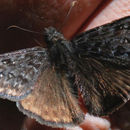buom viet nam
provided by EOL authors
dep, mau den, lon
Conservation Status
provided by University of Alberta Museums
No obvious concerns.
- license
- cc-by-nc
- copyright
- University of Alberta Museums
Cyclicity
provided by University of Alberta Museums
The flight of the single annual brood peaks in late May to early July, depending on habitat.
- license
- cc-by-nc
- copyright
- University of Alberta Museums
Distribution
provided by University of Alberta Museums
The Persius Skipper occurs in western North America in a broad band from Alaska and northeastern Quebec south to California, Arizona and New Mexico. There are a series of populations disjunct from the western populations, occurring from the western Great Lakes region east to the Atlantic seaboard (Layberry et al. 1998, Opler 1999). The disjunct western and eastern populations, and the apparent differences in foodplants, suggest the taxonomy of these populations warrants further research.
- license
- cc-by-nc
- copyright
- University of Alberta Museums
General Description
provided by University of Alberta Museums
"The duskywing skippers (genus Erynnis) can be a challenge to identify, particularly in prairie habitat where all three species may occur together. The white spots in the forewing tip are useful characters for separating these species: Persius and E. afranius both have at least two (usually three or four) spots, while the Dreamy Duskywing (Erynnis icelus) has only one spot or none at all. Persius and Afranius are more difficult to separate; Persius is more grey in colour, not brown, and the fore- and hindwing have contrasting grey (forewing) and grey-brown (hindwing) colours; Afranius is more evenly-coloured. Individuals from short-grass prairie habitat in August are almost certainly Afranius, since Persius does not have a second brood. Uncertain specimens must be dissected for diagnostic characteristics of the male genitalia; see Scott (1986) and Guppy & Shepard (2001) for illustrations.
Layberry et al. (1998) attribute only subspecies borealis to the Alberta fauna, while Bird et al. (1995) assign northern and southern populations to subspecies borealis and fredericki, respectively."
- license
- cc-by-nc
- copyright
- University of Alberta Museums
Habitat
provided by University of Alberta Museums
Forest edges and clearings, meadows and woodlands. Restricted to river valleys in the prairies.
- license
- cc-by-nc
- copyright
- University of Alberta Museums
Life Cycle
provided by University of Alberta Museums
"The egg is pale yellow at first, turning orange as it matures (Bird et al. 1995). Larvae are pale green with a dark dorsal line and a dark brown head, and the pupa is pale-spotted and dark green (Bird et al. 1995). Males perch to await females (Bird et al. 1995).
The use of willows and poplars as larval hosts is unusual given the preference for legumes elsewhere, and these host records appear to be restricted to New England populations (Guppy & Shepard 2001). There is no evidence that western populations feed on plants in the willow family (Salicaceae) (Hooper 1973, Guppy & Shepard 2001)."
- license
- cc-by-nc
- copyright
- University of Alberta Museums
Trophic Strategy
provided by University of Alberta Museums
Vetch (Astragalus sp.) is the presumed larval food plant in southwestern Alberta, based on female egg-laying observations (Bird et al. 1995). Lupines (Lupinus spp.) are suspected hostplants in Ontario (Layberry et al. 1998) and BC (Guppy & Shepard 2001). Adults take nectar at locoweed (Oxytropis spp.) and golden bean (Thermopsis rhombifolia) in Saskatchewan (Hooper 1973).
- license
- cc-by-nc
- copyright
- University of Alberta Museums
Erynnis persius
provided by wikipedia EN
Erynnis persius, commonly known as Persius duskywing,[1] is a species of butterfly in the family Hesperiidae that occurs in North America. It is a threatened species in Michigan and is protected by law.[2] The subspecies Erynnis persius persius is listed as endangered in the Connecticut by state authorities.[3]
Description
The upperside of both the forewings and hindwings are a dark brown color. The forewing has clear spots with other dim markings and the patch at the end of the cell is gray. Males have raised white hairs on their forewings. The hindwings are fringed with darker brown to black and have another fringe that is creamy white. Females have a scent scale patch on their 7th abdominal segment.[4] Caterpillars of this species are light green with a reddish cast and covered with fine, short hairs. Their head is all brownish black.[5] Caterpillar hosts include Lupine (Lupinus), golden banner (Thermopsis), Lotus, and other legumes. Adults feed on flower nectar.[6] The larval form of subspecies E. persius persius is dependent on the wild blue lupine, Lupinus perennis, as a host plant.[7]
References

- license
- cc-by-sa-3.0
- copyright
- Wikipedia authors and editors
Erynnis persius: Brief Summary
provided by wikipedia EN
Erynnis persius, commonly known as Persius duskywing, is a species of butterfly in the family Hesperiidae that occurs in North America. It is a threatened species in Michigan and is protected by law. The subspecies Erynnis persius persius is listed as endangered in the Connecticut by state authorities.
- license
- cc-by-sa-3.0
- copyright
- Wikipedia authors and editors

